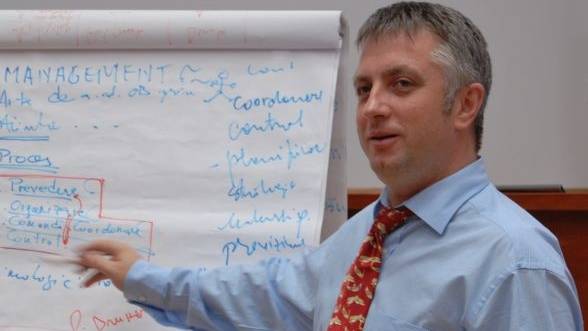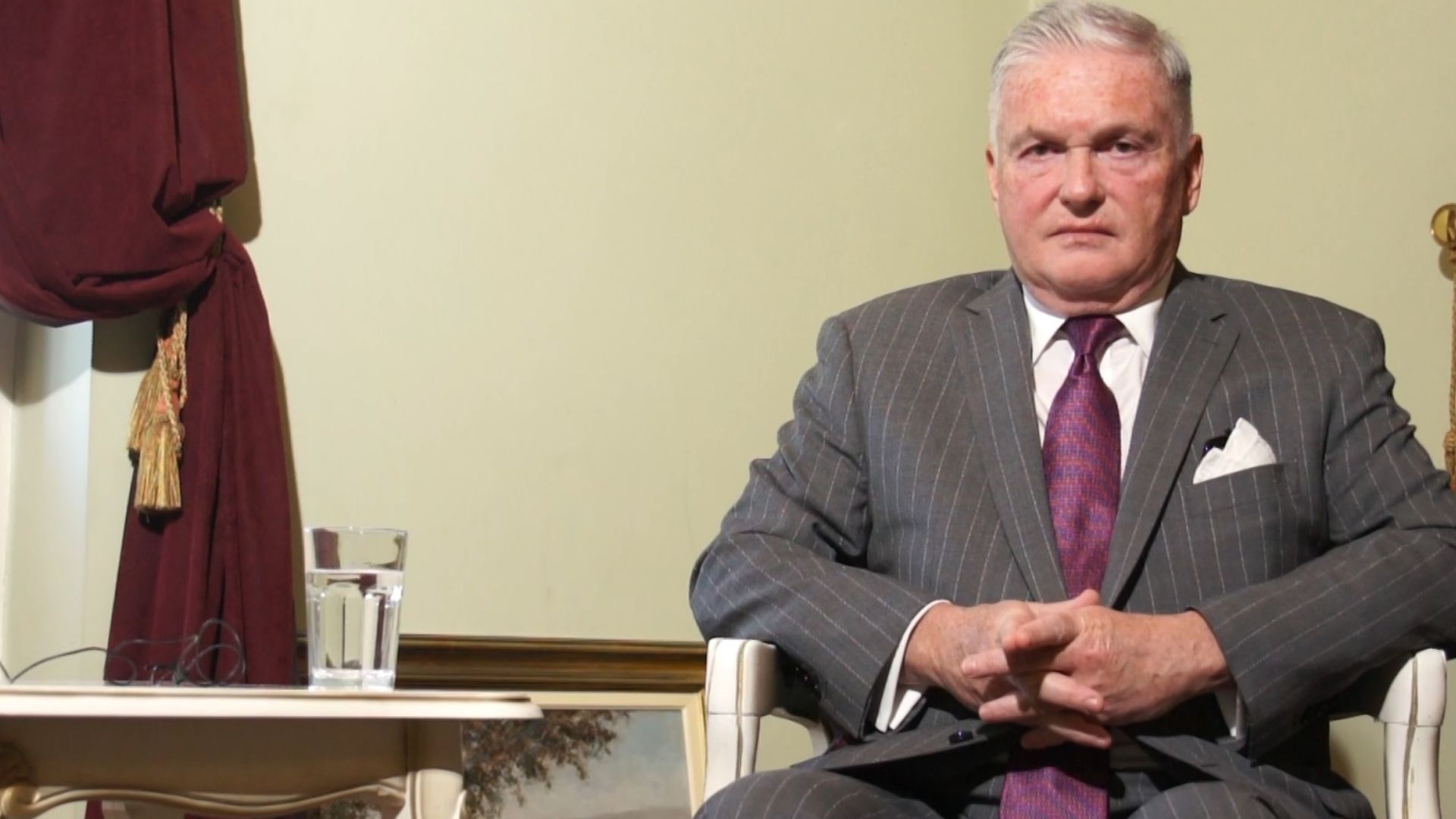Cînd locatarul Casei Albe nu crede că rolul guvernului este să facă din economie o pîrghie pentru realizarea de programe de inginerie socială şi în schimb crede că singurul lucru necesar este să creeze condiţii stimulante pentru cetăţeanul privat sau corporatist de a produce cît mai nestînjenit şi profitabil, mediile progresiste intră în ipohondrie.
In the 1980s, there was a consensus among the members of the national media that Ronald Reagan was going to fail and that he was going to bring on economic disaster. But… the economy didn’t collapse. In fact, it soared to unprecedented levels.
The media stubbornly refused to admit that „Reaganomics” was responsible. The drumbeat of negative opposition to the president’s policies continued through the 1980s. By 1986… the ratio of negative to positive stories was seven to one. In other words, as the economy was improving, media reports on the economy were becoming increasingly negative.
One of the most common allegations in these reports was that the poor got poorer under Reagan, even though the actual number of poor declined from 14 to 13 percent during his administration, and the average income for the lowest one-fifth of Americans rose from $7,008 to $9,431.
Inflation declined 48%, from 8.9 to 4.6%. Unemployment declined 45%, from 7.5 to 5.2.%. Interest rates declined 71.9%, from 21 to 5.9%. Twenty-one million new jobs were created. The so-called „greedy ’80s” witnessed the largest peacetime economic expansion in our nation’s history, yet the media remained deaf, dumb and blind.
A Case Study in Liberal Bias
Imprimis, vol. 23, no. 11, noiembrie 1994
Rîndurile de mai sus sînt relevante şi pentru felul în care e caracterizată economia americană sub administraţia Bush. Toţi aceşti ani s-a lucrat de zor la convingerea publicului că incompetenţa actualului preşedinte american a torpilat realizările din epoca de aur a administraţiei Clinton. Realitatea e totuşi alta. Economia americană a dat dovadă de o rezilienţă remarcabilă în ultimul sfert de secol şi ascensiunea începută sub Reagan a continuat cu pauze minore pînă în prezent. Între perioada de expansiune economică a administraţiei Clinton si cea a administraţiei Bush există o continuitate pe care mini-recesiunea din 2000 şi 2001 nu a reuşit să o fractureze iremediabil. Acest lucru devine evident în următoarea analiză a perioadei 1995-2004.
Opponents of trade liberalization have sought to indict free trade and trade agreements by painting a grim picture of the economic state of American workers and households. They claim that real wages have been stagnant or declining as millions of higher-paying middle-class jobs are lost to imports. But the reality for a broad swath of American workers and households is far different and more benign.
Contrary to public perceptions:
Trade has had no discernible, negative effect on the number of jobs in the U.S. economy. Our economy today is at full employment, with 16.5 million more people working than a decade ago.
Trade accounts for only about 3 percent of dislocated workers.Technology and other domestic factors displace far more workers than does trade.
Average real compensation per hour paid to American workers, which includes benefits as well as wages, has increased by 22 percent in the past decade.
Median household income in the United States is 6 percent higher in real dollars than it was a decade ago at a comparable point in the previous business cycle. Middle-class households have been moving up the income ladder, not down.
The net loss of 3.3 million manufacturing jobs in the past decade has been overwhelmed by a net gain of 11.6 million jobs in sectors where the average wage is higher than in manufacturing. Two-thirds of the net new jobs created since 1997 are in sectors where workers earn more than in manufacturing.
The median net worth of U.S. households jumped by almost one-third between 1995 and 2004, from $70,800 to $93,100.
The large majority of Americans, including the typical middle-class family, is measurably better off today after a decade of healthy trade expansion.
Trading Up — How Expanding Trade Has Delivered Better Jobs and Higher Living Standards for American Workers
Cato Institute, octombrie 2007
În mai 2006, Karl Rove a răspuns astfel criticilor programului economic susţinut de Bush, orientat pe trei direcţii principale: reducerea impozitelor, liberalizarea comerţului şi prudenţă bugetară.
Let me deal briefly with each one of these three: taxes, trade and spending.
In response to the economic challenges the country faced, President Bush provided Americans with the largest tax relief in a generation. With the help of the Republican Congress, he has secured the path to each of five major tax relief bills. He’s led a successful effort to cut taxes every year he’s been in offices. We’ve seen taxes cut on income, small businesses, dividends and capital gains. The child credit has been doubled, the marriage penalty has been reduced, and the death tax has been put on the road to extinction.
Taken together, these tax cuts have strengthened the economy, increased productivity and created new jobs. Just last week, in a major legislative achievement, Congress passed an extension of the capital gains and dividend tax cuts until the end of 2010, and a signing ceremony will take place on Wednesday.
An important point about the impact of the capital gains and dividend tax cuts: Between May 28th, 2003, when the president signed the legislation into law, and December 31st, 2005, the 500 leading U.S. companies on the S&P 500 have increased their dividend payments 725 times, and quarterly dividend payments averaged almost $47 billion a quarter. That is a 51 percent increase compared to the quarterly average for the 10 years previous to the tax cut.
That’s money that is going into retirement funds and IRAs and people’s pocketbooks.
President Bush’s tax-cutting policies were not passed by unanimous consent. Some in Congress oppose any significant tax cut.
Indeed, some members of Congress predicted economic ruin if the president’s tax relief was passed, any part of it. One critic called it, quote, „akin to arsenic poisoning for the economy.”
Another said it was, quote, „nothing more than a sham wrapped in spin, shrouded with deception.”
And a third said it, quote, „would bestow,” quote, „no real benefits on most Americans.”
Now, these aren’t arguments. They’re the political equivalent of schoolyard jeers. But more substantive points were raised in opposition.
One criticism was, quote, „the vast majority of its benefits were directed toward the wealthy,” end quote.
If this were true, then logic tells you that the percentage of federal income taxes paid by the wealthy would be falling after the tax cuts. That is not the case.
The Bush tax cuts have shifted more of the burden onto the wealthy and those lower on the economic ladder have been relieved of a larger share of their tax burden.
The top 1 percent of the nation’s earners, those making more than $317,000 a year, their share of income tax payments is up by 1.5 percent.
For the top 3 percent, those that have incomes are over $200,000, their share of the tax burden is up more than 5 percentage points, from 40.5 percent of the tax burden to 46.6 percent.
And the tax burden of the top 5 percent of those in America, those with incomes of lower than $141,000 a year, is up almost 3 percentage points.
According to the Wall Street Journal, for every 100 Americans today, the wealthiest three are paying taxes equivalent to the other 97 combined.
Another critic’s claim is that, quote, „the tax cuts have played a major role in the return to deficits and debt.”
The problem with this critique is it ignores that tax revenues are at an all-time high, in large measure because of the economic growth the tax cuts contributed to.
Last year, for example, revenues confounded the experts by surging $274 billion above forecasts. That’s almost 15 percent.
And it is happening again this year. Last week, the Treasury Department’s most recent survey shows that tax receipts were up by $137 billion, or more than 11 percent, for the first seven months of fiscal year 2006. Corporate income tax receipts were up nearly 30 percent. While individual income tax receipts have increased by 10 percent in what has been dubbed a, quote, „revenue tsunami.”
If revenues for 2006 grow by 11 percent, then federal taxes will be equivalent to 18.4 percent of the economy; higher than the 40-year historical average.
In the words of the Wall Street Journal, this is, quote, „the largest two-year increase in tax revenue collections, after adjusting for inflation, that has ever been recorded.”
The surge in revenues means that we are on track to achieve the president’s goal of cutting the deficit in half by 2009. And it’s worth noting that just the other day the CBO lowered its deficit forecast for this year, predicting that the large increase in tax revenues would cut the deficit to about 2.5 percent of GDP.
Another criticism, a strange one, of the tax cuts came from a former high-ranking Democrat official who dismissed the tax cuts by saying, quote, „We had very good markets in the ’90s before all these tax cuts went into effect,” end quote.
I’m not certain that most Americans would applaud returning to the end of 2000, when the Dow had just experienced its first calendar drop since 1994 and the Nasdaq had dropped by 50 percent a year.
It’s not just that the critics predicted nearly the opposite of what happened after the tax cuts were passed. The president’s critics were not only wrong, they could not have been more wrong.
Take the frequent claim that the president, quote, „failed to put forth a responsible economic plan to create jobs,” end quote. We saw a lot of variations of this during the calendar year of 2004 but the charge is simply not true.
The American economy has created more jobs than all the countries in the Euro zone and Japan combined, and our economy is growing today faster than that of any major industrialized nation in the world.
It grew at an annual rate of 4.8 percent in the first quarter. It added more than 5.2 million jobs in the last two and a half years.
Employment is at near all-time high. Claims for unemployment insurance are at a five-year low. The unemployment rate is 4.7 percent; well below the average for each of the last three decades.
Core inflation remains low: just over 2.1 percent for the past 12 months. Mortgage interest rates remain near historic lows. And homeownership remains near a record high, with sales of new and existing homes reaching record levels in 2005.
Real disposable income has risen almost 14 percent since President Bush took office. The Dow Jones industrial average is near its all-time high. And since the 2003 tax cuts have been passed, asset values, including homes and stocks, have grown by $13 trillion.
The reality is that the tax cuts have helped make the American economy the strongest in the world.
A second component of the president’s economic policy is free trade. President Bush believes trade is an important source of good jobs for our workers, higher growth for our economy, and bigger earnings for our farmers and our factories.
For example, exports accounting for roughly one-quarter of all U.S. economic growth in the ’90s, and jobs in exporting plants pay wages that are up to an average of 18 percent higher than jobs in nonexporting plants.
Free trade has a proven record of creating new opportunities for our entrepreneurs, expanding choices for American consumers and raising living standards for all our families.
America is once again, under this president, in the business of promoting free and open trade, to build our prosperity and to spur economic growth.
Under the president’s free trade agenda, the U.S. has completed 14 bilateral trade agreements since 2001.
And how important is it to expand economic freedom through free trade agreements? Our free trade partners represent 14 percent of the world’s GDP, excluding the United States from the world total, and yet they represent 52 percent of all U.S. goods exports in 2005 — 14 percent of the world but 52 percent of our economic exports.
Clearly, it is in our interests to tear down walls to the sale of American goods and services around the globe.
The third component of the president’s economic policy is restraint of federal spending.
The president has reduced the growth of nonsecurity discretionary spending every year in office. In the final year of the previous administration, nonsecurity discretionary spending grew by 15 percent.
President Bush worked with Congress to cut that figure, reducing nonsecurity discretionary spending growth to 6 percent in FY ’02, 5 percent in FY ’03, 4 percent in FY ’04 and 3 percent in FY ’05.
For FY ’06, the president worked with Congress to actually cut nonsecurity discretionary spending from the previous year’s levels — the first time since the Reagan administration — and hold growth in total discretionary spending below the rate of inflation.
The president’s FY ’07 budget again proposes that nonsecurity discretionary spending growth receive an actual cut and that growth in discretionary spending again be held below inflation.
Now, how is this done? Well, take last year. The administration issued 39 veto threats on six major spending bills. And Congress responded to those veto threats by restraining spending to the levels proposed in the president’s budget.
To put it mildly, the impact of the president’s veto messages have been an unreported achievement.
Here’s another fiscal fact people may be unfamiliar with: Under this president, federal spending as a percentage of the economy is lower than that under four of the last five presidents.
And the high water mark for the budget deficit as a percentage of the GDP for this administration — 3.6 percent — is significantly less than it was in the case of the 1980s, when it ranged as high as 6 percent.
The president’s tax cuts, trade liberalization and spending restraint helped strengthen the economy’s foundation and added fuel to our economic recovery; not a bad record.
În calitate de şef de cabinet al preşedintelui, Karl Rove a vorbit de pe o poziţie partizană. E posibil ca realitatea să-l fi contrazis. Să vedem.
Christian Science Monitor, aprilie 2006
US economy’s latest output: better jobs
Bloomberg.com, octombrie 2007
U.S. Economy: Growth Unexpectedly Accelerated
TCS Daily, noiembrie 2007
Just when the news is fully saturated with the idea that the U.S. economy is on the brink of a recession caused by the bursting of the sub-prime lending bubble, we get some surprising news last week: The U.S. economy grew at a 3.9 percent (all growth rates are annualized) from July through September, the fastest rate in six quarters. Exports surged 16.2 percent and consumer spending remained strong.
What’s more, jobs are being created and the unemployment rate remains low. While economists had expected a paltry 80,000 new jobs for October, the government reported 166,000.
Nevertheless, we continue to get doses of worrisome news: home prices are falling, oil prices are rising and consumer confidence (as measured by the Conference Board) is now at the lowest point since Hurricane Katrina.
MSNBC, decembrie 2007
Bush signs bill boosting car fuel economy
Bloomberg.com, decembrie 2007
The U.S. is ending 2007 with a whine rather than a whimper. It is tough to keep track of what’s collapsing faster, home prices or the dollar, and the financial market crisis caused by it has many seers talking recession as we enter 2008.
As always, that delicious negativity receives the lion’s share of media attention. But, in many ways, this past year was a pretty good one, and no, I am not just a talking about Boston’s sports fans. Thus, to ring in the New Year, I present the Top 10 pieces of happy economic news in 2007.
1. Equity markets posted solid gains and price multiples are still low. As of last Friday morning, the Dow Jones Industrial Average had gained about 7 percent for the year, while yielding about 2.25 percent, providing investors with a total return of more than 9 percent. The Nasdaq Composite Index had climbed more than 10 percent, while the Standard & Poor’s 500 Index had provided a total return in the 5.5 percent range. There are no signs of irrational exuberance. The price-to- earnings ratio for the S&P 500, for example, finished the year at less than 19, safely nestled in the historical comfort range.
2. Households are wealthier. In part because of rising equity markets, household net worth increased in 2007, according to the latest numbers from the Federal Reserve. At the start of the year, net worth was $56.1 trillion. By the third quarter, this climbed to $58.6 trillion and probably rose again in the fourth quarter. If changes in wealth affect the economy through consumption, then the affect will be favorable.
….
5. The world economy had another blow-out year. According to the latest Moody’s Economy.com forecast, world gross domestic product grew by 3.9 percent in 2007 after rising 3.6 percent in 2006. In spite of the gloom in the headlines, the most important news in 2007 was that economic freedom is spreading, and the benefits to the world’s citizens of this are skyrocketing.6. The trade deficit declined. As our trading partners become wealthier, they demand more of our products. At the same time, the weaker dollar has made U.S. exports cheaper. Exports have boomed, and the real trade deficit has narrowed, from $624.4 billion in 2006 to an estimated $562.4 billion in 2007.
7. Even in the face of the housing-market bust, economic growth was solid. If someone told me last December that construction of single-family homes would drop in 2007 by 27 percent, about the current estimate from Economy.com, then I would have expected the economy to be in recession. But a collapse of that scale did occur, and annual GDP growth, according to the latest Economy.com estimate, was about 2.5 percent. There are plenty of developed countries that would take that type of growth every year.
8. Job creation was robust. According to the latest jobs report, which covers data through November, the U.S. economy added 1.3 million jobs on net in 2007. The unemployment rate was 4.6 percent in January, and finished the year a smidgen higher at 4.7 percent. Both levels are very low by historical standards.
9. The federal budget deficit declined. According to the Congressional Budget Office’s monthly budget review, the federal budget deficit was only $163 billion for fiscal 2007, a large decline from the $248 billion deficit in 2006. This decline was actually bigger than had been forecast by the CBO last January.
Examiner, ianuarie 2008
Only 36 percent of us approve of our president, and fewer still (18 percent) approve of our Congress. We say our confidence has been shattered, and three out of four think our country is “on the wrong track.” So we tell pollsters, as we slink into the new year.
Surprise: The economy added more than 1 million new jobs last year. It grew at an annual rate of between 3 percent and 4 percent. Share prices rose by over 5 percent, with tech shares up by double digits, these gains being recorded in weeks in which the financial markets are said to be in turmoil.
Exports soared, bringing down the long-standing trade deficit. In November, supposedly traumatized consumers splurged, increasing spending by the largest amount in 3½ years. Final figures for Christmas are not yet in, but my guess is that early pessimistic estimates will prove wrong.
…..
But 2007 did not end on a high note. Houses became more like ordinary investments that can decline in value a bit after a spectacular run-up. Foolish lenders found ignorant or greedy borrowers, and made loans that will not be repaid.
…..
Nervous banks, although awash in cash, refused to lend to each other, creating what has come to be called a credit crunch. OPEC cartelists decided that crude oil prices upward of $90 per barrel are nicer than those in the $28 range that they once set as their benchmark. And politicians made it profitable for farmers to grow fuel rather than food, driving food prices to diet-inducing levels.Through it all, the world learned to be careful what it wished for. Foreigners have been berating Americans for „unbalancing” world trade by running huge trade deficits. Finally, the markets agreed, and drove down the dollar.
The result has been an increase in the competitiveness of made-in-USA goods in foreign markets, and a decline in the competitiveness of foreign-made goods in the showrooms of America. The world got what it wished for: a decline in the U.S. trade deficit.
Toate acestea nu înseamnă că economia americană e imună la recesiune în viitorul apropiat. Situaţia fragilă a pieţei imobiliare, criza de credit bancar şi preţurile record ale petrolului pot stopa creşterea economică neîntreruptă din ultimii şase ani. Totuşi, ceea ce rămîne remarcabil e faptul că această creştere economică, însoţită de creşterea generală a nivelului de trai, a fost posibilă în pofida predicţiilor constante de dezastru iminent. Prosperitatea are obiceiul de a nu se conforma tiparelor ideologice.










![marius-bostan-foto[1] marius-bostan-foto[1]](https://inliniedreapta.net/wp-content/uploads/elementor/thumbs/marius-bostan-foto1-qt9ywoo2b2lgv37b76h9qr5yo6db5vwzoxbuvd4e6o.jpg)












1 Comment
Francesco
3 January 2008Economia americana a inregistrat ultimele 24 de trimestre, deci 6 ani de crestere neintrerupta, lucru care arata ca este intr-o forma mult mai buna decat economia Europei, atat procentual cat si ca tendinta.
http://www.american.com/archiv…..omy-stupid
Acest lucru se manifesta deja in discursurile politice ale candidatilor democrati si republicani, problemele politicii externe cazand pe locul doi.